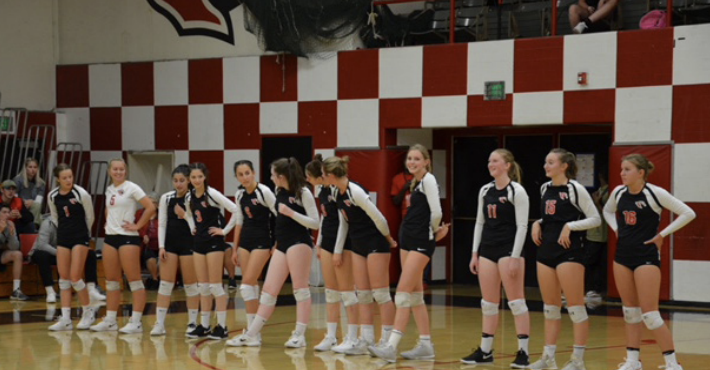Low turnout for women’s sports
Photo courtesy of Andrea Vintro
Girl’s volleyball team recieves low turn out for their games, similar to the girl’s soccer team and other girls athletic teams.
January 2016: the rowdy Lincoln crowd overflows the gymnasium. The bleachers are packed from shoulder to shoulder as friends and family cheer on the men’s varsity basketball team in a battle against a close rival, the Wilson Trojans.
Just below the court, the girls’ varsity team is preparing in excitement, as they can hear the vast size of the crowd above. Among this group of girls is Alexis Heald, a freshman at the time. The buzzer echoes throughout the locker room, concluding the men’s game. Heald and her team enter the court to begin their warm-ups in front of the large crowd.
Instead, to their astonishment, the crowd began thinning instantly, and within minutes, the crowd consists only of a few close family members and friends of the players.
Heald recounts the feeling shared amongst the team.
“This was extremely frustrating for all of us,” says Heald. “It was obvious that the crowd didn’t care to watch us because we are the women’s basketball team.”
While basketball does hold the largest gap in attendance according to athletic director Jessica Russell, it would be false to say they are the only ones who experience this disparity. In fact, one of the largest attendance gaps is felt by the softball team.
“Our girls on the softball team hardly expect any crowd at all,” says Pearl Brumm, a senior pitcher.
Brumm mentions how their games are not held at home, as Lincoln does not have a baseball or softball field, which makes accessibility hard for students. However, this doesn’t entirely account for the attendance gap.
“At one point or another, most of us have attended a boys’ baseball game. They share the same field accessibility situation as us, but they seem to rally up a decent crowd, especially come playoff time,” says Brumm.
Junior goalie, Ella Birdsall, and senior midfielder, Gwynn Llewelyn, of the women’s varsity soccer team share similar opinions of the relatively smaller attendance at their games
Last year, during the 2017-2018 soccer season, both the girls and boys entered the playoffs. Despite the accomplishments on both sides, the men’s team seemed to snatch up all the attention from the girls, claims Birdsall.
“People got way more excited about the guys’ games,” says Birdsall.
After the boys fell to West Linn in the first round of the playoffs, the girls won their first round in a 3-2 victory over McNary. They continued through to three more rounds, eventually falling to Jesuit in the semifinals. This was the highest the girl’s soccer team had placed in over five years.
Despite their success coupled with the early elimination of the boys’ team last year, the bleachers were empty.
“People didn’t even know that we were still in the playoffs, even after the guys lost in the first round,” says Birdsall. “It wasn’t until the team made the school announce it over the intercom that people began hyping us up.”
This came as no surprise to Llewelyn, who was then in her third year as a varsity soccer player.
“People have always shown up to more guys’ games than girls’ games, despite what time of the year it may be,” says Llewelyn.
Senior Lincoln student, Altair Fazio, shares her opinion straightforwardly.
“Girl’s sports just aren’t taken as seriously.”
It’s a school-wide reality, however, it isn’t a hopeless situation. The Lincoln athletic program has begun looking into the problem to try and put a shift to this “undesirable” part of Lincoln’s culture.
Russell, who has been AD for three years, believes a shift in the Lincoln mindset is critical to accomplishing a change in attendance She is working in tandem with the drama department. They are combining their efforts to raise attendance levels at sporting events and performances.
“It’s not what I can do for me, it’s what can I do for all of us,” says Russell.
During the homecoming night football game, drama teacher and play producer Jim Peerenboom took a proactive stance in hopes of increasing play attendance. To capture the attention of the fans at perhaps the most attended Lincoln sporting event, Peerenboom set up a tailgate with pizza and cornhole. A sign posted on the front of his Truck read, “Go Cards!”
“If we ask people to come to our shows, then we should probably also support what they are doing,” says Peerenboom.
Russell supports this idea and would like to adapt it to the culture of Lincoln sports.
One idea that’s been suggested is that two men’s and women’s sports teams pair up and commit to attending one another’s games.This could ensure a more equal representation and an overall rise in support for woman athletics.
Until an idea is put into place, however, the Lincoln culture will likely not make any sudden changes.
As Brumm says, “It is just a sad reality that [low fan turnout] is a constant expectation for us and other women’s sports teams.”


